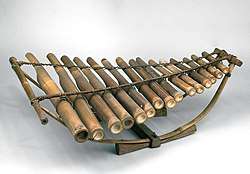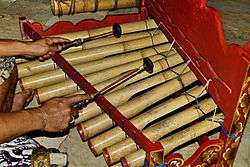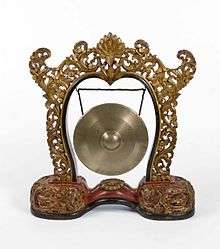Calung
A Calung is a bamboo tube xylophone used in the Indonesian music of Javanese and Balinese.
 | |
| Percussion instrument | |
|---|---|
| Classification | Idiophone |
| Hornbostel–Sachs classification | 111.232 (Set of percussion tubes) |
 | |
| Percussion instrument | |
|---|---|
| Classification | Idiophone |
| Hornbostel–Sachs classification | 111.212 (Set of percussion sticks/Xylophone) |
The Calung (instrument) consists of multiple bamboo tubes which are struck at the base to produce a woody sound. In the Balinese Gamelan gong kebyar, the metallophone Jublag can also be known as Calung, it has a one-octave range, and is generally utilized to play mid-range melodies.
In Banyumas, southwestern Central Java in Indonesia, when Calung is referred to as an ensemble, it uses multiple bamboo instruments and is composed of singers and dancers.[1] The ensemble is characterized by a variety of traits that include: interlocking melodies and rhythm, abrupt changes in tempo, as well as syncopated rhythm and humorous vocals. Calung (the ensemble) is present at many celebratory gatherings, and its dancers are sometimes related to prostitution.[2]
Construction/Design
The Calung works by cutting away multiple pieces of bamboo tubes to create a pitch when struck.[3] To make the Calung in the Sundanese tradition, a set of bamboo tubes are strung together through holes cut into the tubes. You are then able to play the Calung either suspended; you play the tubes while they are in hanging in front of you, or you can put them across a bamboo frame and play it like a xylophone.
See also
References
- (2007). "Calung". Grove Music Online (8th ed.). Oxford University Press. 2007. Retrieved 9 Sep 2013.
- Sutton, R. Anderson (1991). Traditions of Gamelan Music in Java: Musical Pluralism and Regional Identity. Cambridge University Press.
- Yampolsky; et al. (2001). "Indonesia". Grove Music Online (8th ed.). Oxford University Press. Retrieved 8 September 2018. Section (b): Village music.
External links
- (August 2, 2011). "Calung Traditional Art from West java", Antique-Teak-Furniture.BlogSpot.com. An example of a Calung ensemble can be found in the video halfway down the page.

